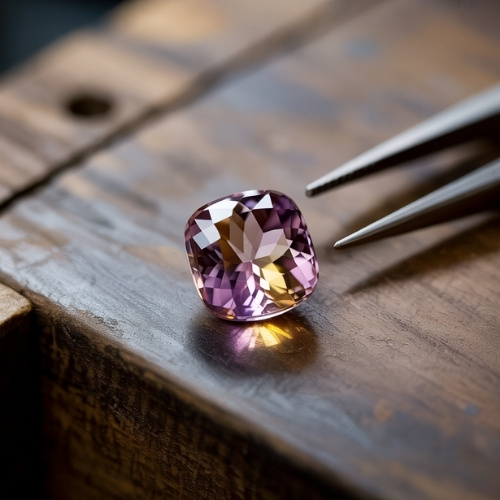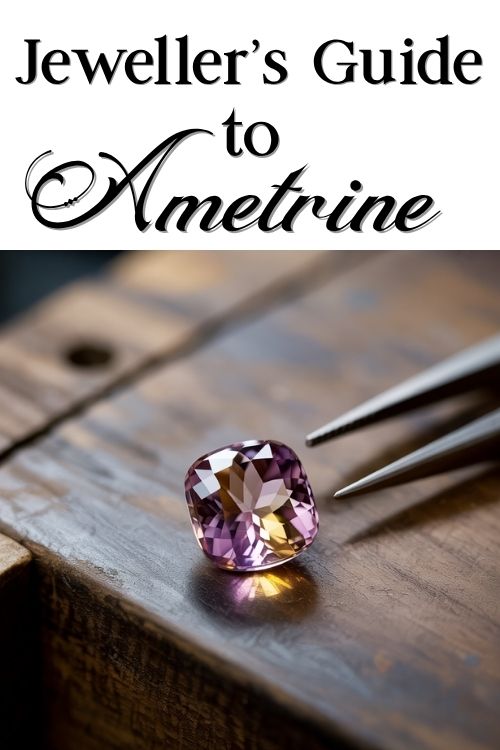Estimated reading time: 4 minutes
Ametrine is one of nature’s most mesmerising creations. This striking quartz variety combines zones of regal purple amethyst and warm golden citrine in dramatic, often geometric partitions. Naturally occurring and quite rare, ametrine is a compelling choice for jewellers seeking something bold, balanced, and beautiful.
Jump to:
Basic Identification Information
Name & Synonyms
Ametrine; also known as bolivianite (from its primary source, Bolivia)
Species
Quartz
Colour Range
Bi-colour zones of purple (amethyst) and yellow to orange (citrine); typically sharply defined but occasionally blended
Refractive Index
1.544–1.553
Birefringence
0.009
Optical Sign
Uniaxial +
Pleochroism
Weak to Moderate 2 Colours
In the purple section it will be purple to reddish purple.
If it’s there in the yellow section it will be very weak shades of yellow or orange.
Specific Gravity
2.65
Fluorescence
Inert to weak
Lustre
Vitreous (glass-like)
Clarity
Type 2
Often included, though eye-clean examples are not uncommon
Gems Often Mistaken For
Bi-colour tourmaline, fluorite
Mohs Hardness
7
Wearability
Good — suitable for most jewellery types with standard precautions
Birthstone
Not officially a birthstone, but could be used in place of amethyst (February) or citrine (November)
Spotting Synthetic (Lab-Grown) Ametrine
Synthetic ametrine is readily available and often produced via hydrothermal methods. Visually, lab-grown stones tend to be too perfect with exceptionally vivid colour contrast and no inclusions.
Common Treatments
Most natural ametrine on the market is untreated, with its unique colour zoning caused by naturally occurring iron oxidation during crystal formation.
However, artificial ametrine may be created by heat-treating or irradiating amethyst to induce citrine-like zones. These are less common but worth noting, particularly when colour boundaries appear overly smooth or unnatural.
Durability & Setting Considerations
Ametrine’s Mohs hardness of 7 makes it durable enough for everyday jewellery, but it still warrants care. It can be scratched by harder stones, and prolonged exposure to strong sunlight may cause colour fading over time.
When setting ametrine, orientation is everything. Position the stone to highlight its bi-colour nature. Protective settings, such as bezels or secure prongs, are ideal for rings and daily-wear pieces.
Be mindful of heat: ametrine should never be cast in place, as high temperatures can permanently alter or dull its vivid colours.
🛍️ Explore our selection of pre-owned Ametrine Gemstones for your next jewellery creation.
Care Instructions
Cleaning
Use warm, soapy water and a soft brush. Avoid ultrasonic or steam cleaners, as they may damage the gem or affect its colour.
Storage
Store ametrine separately from harder gemstones to prevent surface scratches. Soft pouches or fabric-lined compartments are ideal.
Daily Wear
Although suitable for regular wear, ametrine should be treated with a little mindfulness. Avoid prolonged sun exposure, and remove before strenuous activities to preserve its polish and colour integrity.
Market & Ethical Notes
Natural ametrine is relatively rare and primarily sourced from the Anahí mine in Bolivia. Its limited origin makes provenance easier to verify, especially when working with trusted suppliers. This exclusivity also adds value for jewellers seeking to offer something distinctive yet meaningful.
Synthetic versions present a budget-friendly and potentially more sustainable option, particularly for larger pieces or fashion-forward designs.
🔗 Learn more about the ethical and environmental story behind Reclaimed and Recycled Gemstones.
Symbolic & Spiritual Meanings
Ametrine is widely regarded as a stone of balance and clarity. Merging the uplifting energy of citrine with the calm, introspective qualities of amethyst. It’s often associated with mental clarity, emotional harmony, and creative flow. Energetically, it’s linked to both the crown and solar plexus chakras, symbolising alignment between thought and action.
🔗 Dive deeper into Ametrines Symbolic & Spiritual Meanings
Etymology
The name “ametrine” is simply a combination of its two components: amethyst and citrine. Though the gem has likely been known to indigenous peoples for centuries, its commercial use began in earnest in the 20th century after deposits were discovered in Bolivia, giving rise to the synonym bolivianite.
🔗Curious about how ametrine was viewed in ancient cultures? Explore its fascinating myths and legends
📌 Save this jeweller’s guide to ametrine for quick reference next time you’re working with this stunning gem.


